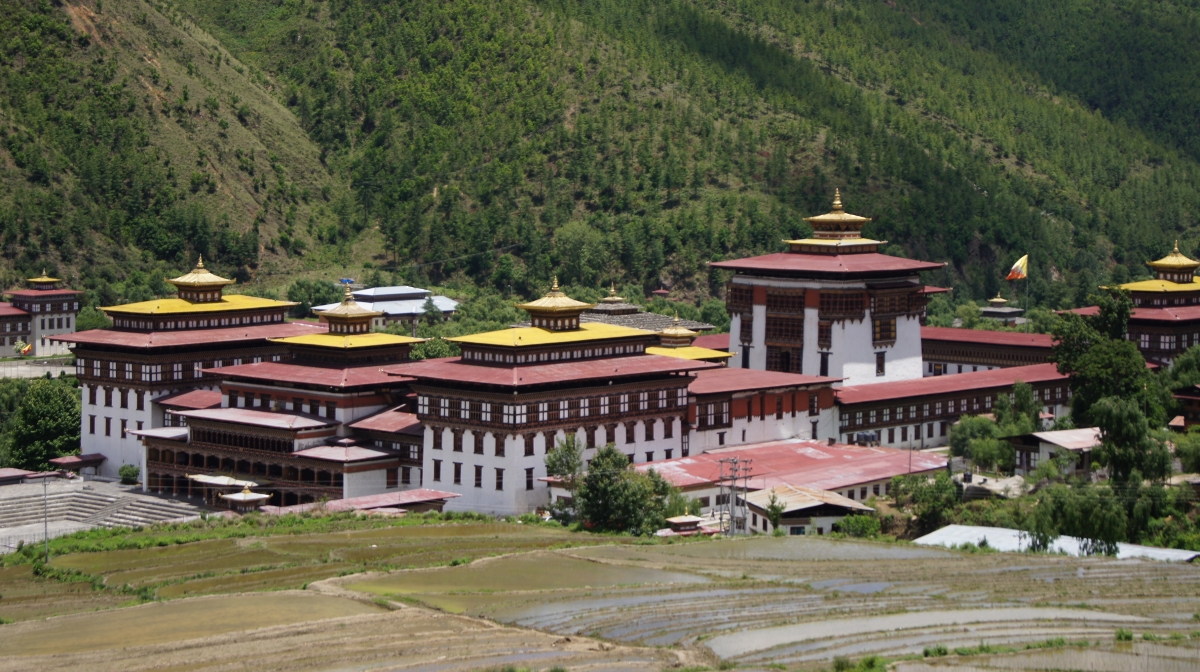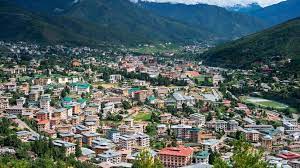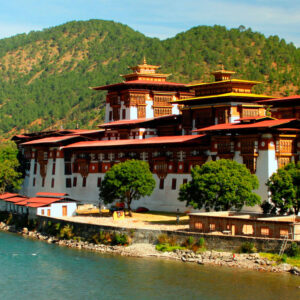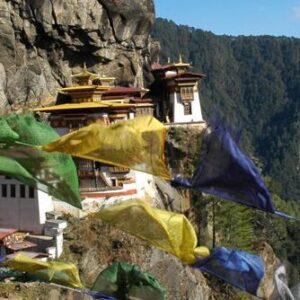Bhutan Itinerary featuring Hikes
Day 01 Arrive Delhi
Arrive in Delhi by international flight. You will be by our representative in the arrival hall. He will then take over to assist you with the transfer and check in at hotel.
DELHI: The capital city of Independent India is often the starting point of a visit to India . Like Rome it is an eternal city and is a name with music in it for most of the people. For Indians it is the capital of their country, the centre of power and cultural; for the simple villager it is identified as the home of Panditji, as Mr. Nehru was affectionately known. For foreigners who have read of it in their newspaper and seen on their Television, it is a strange, and sometimes puzzling blend of ancient and modern, of pageantry and socialistic planning.
Overnight at Hotel.
Day 02 Delhi – Paro
Morning transfer to airport to connect flight for Paro.
The flight to Paro on a clear day is one of the most spectacular of all mountain flights. Whether flying along the Himalayan range from Kathmandu or over the foothills from Kolkatta, the journey offers fascinating views and an exciting descent into the Kingdom. The first gift from Bhutan will be cool, clean fresh air as you step out of the aircraft. You will be received by our representative and transfer to the hotel.
Depending upon flight arrival time at Paro, later in afternoon visit, Ta Dzong: once a watchtower, built to defend Rinpung Dzong during inter-valley wars of the 17th century, Ta Dzong was inaugurated as Bhutan’s National Museum in 1968. It holds fascinating collection of art, relics, religious thangkha paintings and Bhutan’s exquisite postage stamps. The museum circular shape augments its varied collection displayed over several floors.
Then, walk down a hillside trail to visit Rinpung Dzong, which has a long and fascinating history. Built in 1646 by Shabdrung Ngawang Namgyal , the first spiritual and temporal ruler of Bhutan, the Dzong houses the monastic body of Paro, the office of the Dzongda (district administrative head) and Thrimpon (judge) of Paro district. It is also the venue of Paro Tshechu, held once a year in the spring.
Later time permitting, taking a trail through the fields, visit on foot the Lango village,.
Overnight at the hotel in Paro . (Altitude 2,280m)
Day 03 In Paro
After breakfast excursion to Taktshang Lhakhang or Tiger’s Nest Monastery ( approx 5 hours round trip walk ) : Perched on the side of a cliff 900m above the Paro Valley floor , it is undoubtedly one of the most famous of Bhutan’s monasteries. Lore has it that Guru Rinpoche arrived here on the back of a tigress and meditated at this monastery thus the name ‘Tiger’s Nest’. This site has been recognized as a most sacred place and visited by Shabdrung Ngawang Namgyal in 1646 and now visited by all Bhutanese at least once in their lifetime. On 19 April, 1998, a fire severely damaged the main structure of building but now this Bhutanese jewel has been restored to its original splendor.
Late afternoon, drive to the farther end of the Valley to the base of Drugyel Dzong, a 17th century fortress burned down in the early 50s. Here we will also see the beautiful typical farm houses, nicely painted.
On the drive towards Paro town en route visit Kyichu Lhakhang, one of the oldest monasteries of the Kingdom reflecting introduction of Buddhism in Bhutan.
Overnight at the hotel in Paro . (Altitude 2,280m)
Day 04 Paro – Haa Valley ( 70 Km.. approx.. 3 Hrs drive)
After breakfast drive to Haa valley, en route taking a short stop at Chelela pass. Located at an elevation of 3,988 meters, Chelela is considered to be one of the highest motorable passes in Bhutan. About an hour’s drive along a thickly-forested road, this Pass is a botanical paradise, providing stunning views of the sacred mountain Jomolhari and Jichu Drake. It is also marked by hundreds of prayer flags fluttering in the wind.
From Chelela, embark on a fascinating excursion to Kila Gompa, a nunnery perched on a steep cliff face at 3500m. This staggering site manages to house 7 small temples and about 70 nuns. From Chelela pass, the Gompa is about an hour walk amidst magnificent wooded area.
After lunch at Chelela pass, drive onward to Haa valley. The Haa valley was opened for the first time to foreign tourists in 2002. Also known as the “Hidden-Land Rice Valley”, Haa is culturally rich valley and some of famous sites in this region are: 7th century Lhakhang Karpo (White temple) and Lhakhang Nagpo (Black temple) at the foothills of a venerated three brotherly mountains known as Meri Puensum. The Valley of Haa lies on the western most edge of Bhutan, its northern boundaries with the Chumbi Valley of Tibet, dividing it from the Indian province of Sikkim. Haa is one of the 20 districts or dzongkhags of Bhutan and one of the least populated. Most of its landmass is covered by dense forest and the remainder under fields of wheat and barley, with a little rice towards its lower reaches and the accessible side valleys. Meadows support the raising of yak, cattle, chicken, pigs and horses.
Evening explore town and its market area.
Overnight at the hotel in Haa valley. (Altitude 2,670m)
Day 05 Haa Valley – Thimpu ( 115 Km /. 4 Hrs drive)
After breakfast drive to Bhutan’s capital town Thimphu with en route stop at Dogar Dobji Dzong, a 16th century structure, built by the brother of the Divine Madman, Drukpa Kinley. Legend has it that the statue of the Guru Landrachen housed here, complained when the apostate Tibetan monarch Langdharma tried to smash it with a hammer. This dzong became Bhutan’s first jail in 1976 but has since returned to its monastic origins.
Drive onwards, stopping en route at Chuzom, the confluence of Paro and Thimphu rivers.
The capital town of Bhutan and the centre of government, religion and commerce, Thimphu is a unique city with unusual mixture of modern development alongside ancient traditions. Home to civil servants, expatriates and monk body, Thimphu maintains a strong national character in its architectural style. Besides its position as the seat of government, its many glittering monuments, temples, monasteries, dzongs, premier museums and institutions make it an important destination for travelers.
Afternoon, visit Buddha Point (Kuenselphodrang). You can pay your obeisance and offer prayers to the Buddha, the largest statue in the country and then walk around and take a glimpse of the valley.
Later, drive to Trashichhoedzong : This impressive fortress/monastery houses Secretariat building, the throne room of His Majesty, the King and various government offices. It is also the summer residence of Chief Abbot and central monk body.
Evening an exploratory walk around Thimphu main street and market area. Also visit the Local Crafts Bazaar, to browse through example of Bhutan’s fine traditional arts. Here you can buy hand-woven textiles, thangkha paintings, masks, ceramics, slate and wood carvings, jewellery, interesting items made from local materials.
Overnight at the hotel in Thimphu. (Altitude 2,320m)
Day 06 Thimpu – Punakha ( 75 Kms / 3 Hrs drive)
After breakfast, visit National Memorial Chorten: a monument for world peace and prosperity. The paintings and statues inside the monument provide a deep insight into Buddhist philosophy.
Afterwards drive up to, Dochu-la pass (3,088m/ 10,130 ft) stopping briefly here to take in the view and admire the chorten, mani wall, and prayer flags which decorate the highest point on the road. If skies are clear, the following peaks can be seen from this pass (left to right): Masagang (7,158m), Tsendagang (6,960m), Terigang (7,060m), Jejegangphugang (7,158 m ), Kangphugang (7,170 m ), Zongphugang (7, 060 m ), a table mountain that dominates the isolated region of Lunana – finally Gangkar puensum, the highest peak in Bhutan at 7,497m.
From Dochula, embark on a fascinating walking excursion to Lungchuzekha Goemba. It is an interesting three hours round trip walk, offering fascinating view of Bhutan Himalayas. From 108 chortens and mani wall at Dochula pass, the road ascends gradually into white, red and pink rhododendron forests for about one and a half hour with some steep sections before branching left to Lungchuzekha Goemba. The highlight of this excursion is beautiful forest, spectacular mountain views and monastery.
Afterwards, drive onward to Punakha / Wangdue.
Punakha served as the capital of Bhutan and seat of government until 1955 and still it is the winter seat of Je Khenpo (the chief abbot). Linked to some of the most momentous events in Bhutanese history, in 1651 Punakha was chosen to be the capital and two and half centuries later, in 1907, Punakha was, again the place where Bhutanese people elected the first king, Gongsar Ugyen Wangchuk. Blessed with temperate climate and owing to its natural drainage from Pho Chhu (male) and Mo Chhu (female) rivers, the fertile Punakha valley produces abundant crops and fruits.
Nearby Punakha, Wangduephodrang is the last town on the central highway before central Bhutan. The town is not more than an enlarged village with a few well-provided shops. Located in the south of Punakha, the higher reaches of the Wangduephodrang valley provide rich pastureland for cattle. This district is also famous for its fine bamboo products, slate and stone carvings.
Overnight at the hotel in Punakha / Wangdue. (Altitude 1,300m)
Day 07 Punakha – Gangtey ( approx.. 85 Kms /4 Hrs drive)
After breakfast, continue discovering:
Rinchengang Village: A small clustered village in Wangduephodrang, on a hill opposite to where Wangduephodrang Dzong was built before. It is about 20 minutes hike uphill from the nearest road.
Then drive to Gangtey. The valley of Gangtey is one of the most beautiful spots in Bhutan. The surprise of finding such a wide, flat valley without any trees after the hard climb through dense forests is augmented by an impression of vast space, and extremely rare experience in Bhutan where most of the valley’s are tightly enclosed.
Afternoon visit Gangtey Goemba. Perched on a small hill that rises from the valley floor, the Gangtey Monastery is the only Nyingmapa monastery on the western side of the Black Mountain’sGangtey valley, Bhutan and also the biggest Nyingmapa monastery in Bhutan. The Monastery is surrounded by a large village inhabited mainly by the families of the 140 Gomchens who take care of the Monastery.
A few kilometers beyond the Gangtey Monastery, on the valley floor lies the village of Phobjikha. This place is the winter home of black necked cranes that migrate from the arid plains in the north to pass winter in milder and lower climate. Phobjikha, at an altitude of 2900 m, falls under the district of Wangduephodrang and lies on the periphery of the Black Mountain National Park. Explore Phobjikha valley, by walk.
Overnight at the hotel in Gangtey. (Altitude 3,000m)
Day 08 In Gangtey
TABEDING TO TANGJEY LHAKHANG WALK :
DISTANCE: 11 KM
ALTITUDE: TABEDING( 2870m). TANGJEY LHAKHANG (3050m)
TIME: 5 HOURS EXPLORATIONS
After breakfast, we begin our day. After an hour and half of easy hike in the valley, we reach our first village Kilkhorthang, consisting of about nine household and a beautiful village temple located towards the end of the village. We remain on farm road for about half an hour by when it reaches a vista point and can view distant villages in Phobjikha Valley.
From this wonderful vantage point, we take the road to our left towards Tanjey where it leads with a gradual climb and a breath taking and fantastic approaching sights of the surrounding villages and farmers working in their fields, where they are restricted to the cultivation of buckwheat, potatoes and turnips.
Finally, after about an hour of gradual walk from the road junction, we reach picturesque and spacious hamlet of Tanjey having its temple located above the village with total serenity and dominance from its golden roof.
After our visit inside the temple, we then cross a wooden bridge, following the Chu Karp to your right through the village community school till the bridge across Mr. Snake River, which give access to our way back to the guest house for a late lunch with a special Bhutanese dish of Kewa Datsi (local potatoes with cheese) and Red- rice from Punakha or Wangduephodrang. For those interested, you can have the opportunity to celebrate this wonderful hike with a local traditional drink known as ARA (distilled liquor similar to Japanese drink Saki) . A good way to end the day with a local tone in this beautiful valley.
Overnight at the hotel in Gangtey. (Altitude 3,000m)
Day 09 Gangtey – Punakha ( 70 Kms / 3-4 Hrs drive)
Morning after breakfast drive to Punakha, enroute take a short excursion to Chimi Lhakhang. Situated on a hillock in the centre of the valley, this temple is dedicated to Lama Drukpa Kuenley, who in the late 15th century used humour, songs and outrageous behaviour to dramatise his teachings and due to this also known as ‘Divine Madman’. This temple is also known as the temple of fertility. It is widely believed that couples who do not have children and wanting one, if they pray at this temple, they are usually blessed with a child very soon. It is about 30 minute walk across field from the road to the temple.
Later in the afternoon visit Punakha Dzong and later walk across the suspension bridge (about 200m long) through absolutely fresh breeze and fascinating view of Dzong. Built strategically at the junction of Pho Chhu and Mo Chhu rivers, in 1637 by Shabdrung Ngawang Namgyal to serve as the religious and administrative centre of the region, Punakha Dzong has played an important role in Bhutan’s history. Damaged by four catastrophic fires and an earthquake, the Dzong has been fully restored by the Fourth King. Here the first king was crowned and since then, all coronations and royal events, such as weddings are conducted here. The Punakha Dzong, presently serves as the winter residence of the Central Monastic body. Each winter beginning in November, the monastic body headed by the Je Khenpo, moves to this warmer location.
Overnight at the hotel in Punakha / Wangdue. (Altitude 1,300m)
Day 10 Punakha – Paro (approx.. 125 Kms / 4.5 Hrs drive)
After breakfast drive to Paro en route visiting newly developed Wangduephodrang town.
Drive further ahead and visit Simtokha Dzong, the oldest fortress of the country which now houses the School for Buddhist studies. While entering to Paro valley visit en route Tamchoe Monastery built by Iron Bridge Builder in 14th century.
Evening at leisure in and around Paro city centre, for exploration, shopping etc.
Overnight at the hotel in Paro. (Altitude 2,280m)
Day 11 Paro – Delhi & Leave Delhi
Morning transfer to Paro airport to connect flight for Delhi & then to onward destination.








Reviews
There are no reviews yet.